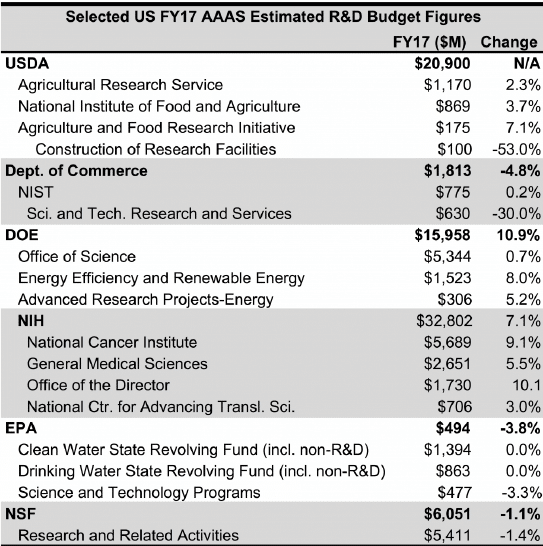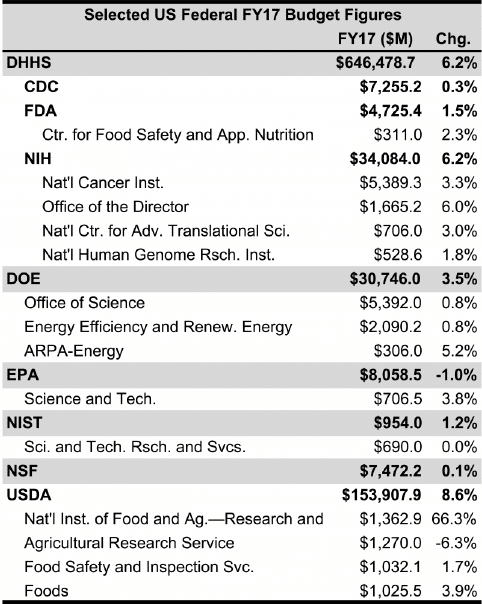News: US FY2017 Budget
Despite the Trump Administration’s proposals to cut US science funding over the last few months, the 2017 Consolidated Appropriations Act, or omnibus bill, indicates a 5.0% rise in total FY17 science R&D to $155.8 billion, according to recent estimates from the American Association for the Advancement of Science (AAAS). Signed into law on May 5, the $1.07 trillion bill is 1.3% higher than the Administration’s requested amount, and a 7.0% decrease from FY16. The AAAS estimates that basic research funding increased 4.1% to $34.9 billion, while applied research funding increased 6.3% to $40.2 billion. R&D funding estimates for development rose 4.0% to $78.1 billion, and facilities and equipment funding increased an estimated 2.9%, totaling $2.7 million. Funding for defense and non defense R&D is estimated to have grown by 6.3% to $82.9 billion and 3.6% to $72.9 billion, representing 53% and 46% of total FY17 science R&D, respectively.
The information in this article is the result of IBO estimates, unless otherwise indicated. The estimates for FY17 are based on Congressional documents, White House explanatory statements and Appropriations Committee press releases.

NIH
The NIH received a total FY17 budget of $34.1 billion, a 6.2% increase. The $2 billion increase includes funding for the 21st Century Cures Act. Similarly to FY16, the budgets of virtually all institutes within the NIH received increases. General Medical Sciences received $1.8 billion, a 3.9% increase, while Environmental Health Sciences’ budget increased 3.0% to $714.3 million. Also increasing 3.0% from FY16 are the budgets for Biomedical Imaging and Bioengineering at $357.1 million, and Complementary and Integrative Health funding at $134.7 million. The BRAIN Initiative budget increased $110 million to $260 million, a 73.3% increase, while Precision Medicine Initiative funding jumped 60%, or $120 million, to $320 million.
According to AAAS estimates, NIH R&D funding accounts for $32.8 billion, or 96%, of the Institute’s budget, with $32.6 billion allocated to the conduct of R&D, and $168 million for R&D facilities and equipment. The estimated AAAS budgets for NIH Buildings and Facilities and the Environmental Health Sciences Superfund remain stationary at $129 million and $77 million, respectively.
FDA
The total budget for the FDA for FY17 increased by $39 million, or 1.5%, to $4.8 billion, with $2.8 billion in new discretionary budget authority and $1.9 billion in definite user fees. The budget includes a general $10 million provision for the prevention of and response to emerging threats to human health, such as the Ebola and Zika viruses.
The law also provided $33.7 million for the implementation of the Food Safety Modernization Act (FSMA), of which $18.7 million is the for the National Integrated Food Safety System and $17.0 million is for Import Safety.
The budget authority for Animal Drugs and Feeds increased 2.6% to $162.9 million, and the Center for Drug Evaluation and Research budget decreased 27.6% to $356.0 million, although funding for its parent program, Human Drugs, overall increased marginally by 0.1% to $492.2 million. Funding for Biologics, which includes the Center for Biologics Evaluation and Research and Field Activities, remained stationary at $215.4 million.
CDC
The CDC received a total of $6.3 billion, with the vast majority of the budget for discretionary funding. And $15 million for the Public Health and Social Services Emergency Fund. Funding for Environmental Health decreased 2.4% to $180.8 million for discretionary funding and $17 million for transfers from the Public Health Fund.

NSF
The NSF total budget grew a meager 0.1% to $7.5 billion. Of this figure, 80%, or $6.0 billion, is allocated for research and related activities, which includes $160 million for the Experimental Program to Stimulate Competitive Research, the same budget as FY16. Major Research Equipment and Facilities Construction received $209 million, up 4.3%, while the Office of the National Science Board’s budget remained flat at $4.4 million.
AAAS estimates indicate that NSF Conduct of R&D funding totals $5.6 billion, a 1.8% decrease, while R&D Facilities received $463 million, a 9.1% increase.
DoE
Funding for the DoE grew 3.5% to $30.8 billion for its science, energy, environment and national security programs. The budget for the Office of Science remained mostly flat at $5.4 million, with marginal increases for many of its departments, such as the budget for Energy Efficiency and Renewable Energy, which increased only 0.8% to $2.1 billion, and High Energy Physics research, which received $731.5 million, up just 0.3%. The budget for Basic Energy Sciences research grew 2% to $1.7 billion, while Biological and Environmental Research grew 0.5% to $612 million. Science Laboratories Infrastructure, which includes infrastructure support, facilities and construction, received a 14% boost to $130 million.
According to AAAS estimates, DoE R&D funding totals $16.0 billion, with $14.9 billion for Conduct of R&D and $1.1 billion for R&D Facilities. By function, the AAAS estimates that the R&D budgets for Defense, General Science and Energy are $7.1 billion, and $3.5 billion, respectively.
EPA
The EPA’s funding decreased by 1.0% to $8.1 billion. The budgets for the vast majority of programs and departments within the Agency either remained flat or decreased for FY17. The EPA’s Science and Technology department received $713.8 million, which was partially offset by a $7.4 million recession, for a total of $706.5 million, a 3.8% decrease.
The budget for Clean Air and Climate and Chemical Safety and Sustainability remained frozen at the FY16 levels of $116.5 million and $125.9 million, respectively. Funding for Water Resources grew 1.9% to $214.8 million. State and Tribal Assistance grants nominally increased 0.3% to $3.5 billion, although Categorical grants, a sub-category within State and Tribal Assistance grants, decreased 1.4% to $1.1 billion.
AAAS estimates indicate that total EPA R&D funding decreased 3.8% to $494 million, with only Oil Spill Response receiving an increase in budget, with $1 million, a 3.6% growth.
NIST
The Department of Commerce’s NIST total budget decreased 1.2% to $952 million allocated to Scientific and Technological Research and Serviced, the same figure as FY16. The law indicated $109 million for the construction of research facilities, down 8.4%, and $153 million for Industrial Technology Services, a 1.3% decrease. Within Industrial Technology Services, the budget for the National Network for Manufacturing Innovation remained flat at $25 million.
The AAAS estimates that for the entire Department of Commerce, R&D budgets have decreased 4.8% to $1.8 billion, a $92 million decrease.
USDA
The USDA received a $12.8 billion boost for its FY17 budget, totaling $153.4 billion, an 8.6% increase. This includes $2.9 billion for agricultural research programs, such as the Agricultural Research Service, which received $1.3 billion, and the National Institute of Food and Agriculture, which received $1.4 billion. Animal and Plant Health received an additional $51.8 million in its budget for a total of $949 million, and an extra $17.2 million for the Food Safety and Inspection Service, totaling $1.0 billion.
R&D funding for the Agriculture Research Service decreased 6.2% to $1.3 billion, according to AAAS estimates, while R&D funding for the National Institute of Food and Agriculture increased 3.7% to $869 million. Including Forest Services, AAAS estimates of total USDA R&D funding is $2.6 billion, down 2.9% from FY16.
This article is from our bi-monthly newsletter Instrument Business Outlook (IBO). Click here to learn more and sign up for a free trial.



